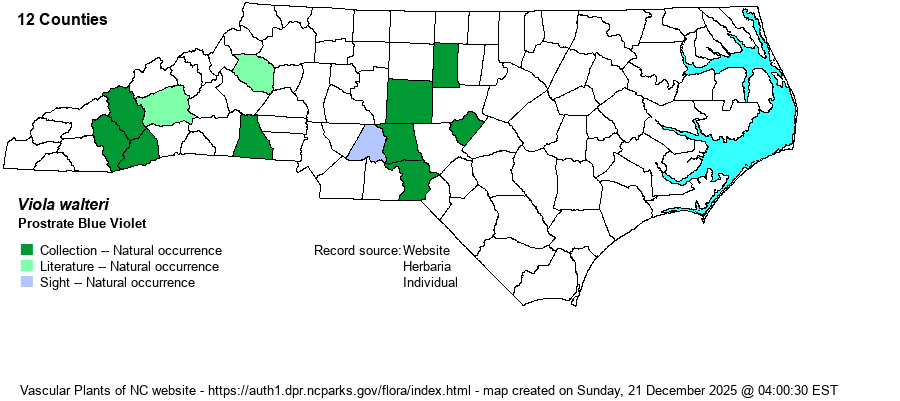| Author | House | |
| Distribution | Two centers of distribution: the southern Piedmont and southern Mountains. SERNEC specimens from Davidson and Durham counties lack images and are not mapped here. A specimen from Buncombe County (Horton 3243 WCUH) is misidentified. A number of iNaturalist photos are Research Grade and do appear to be correct.
This is a Southeastern species, ranging from VA and southern OH south to northern FL and eastern TX.
| |
| Abundance | Very rare to rare in the southern portions of the Piedmont and Mountains. However, there are very few recent records for this species. The NCNHP has its State Rank as S1S2. This is a Significantly Rare species. | |
| Habitat | This is a species that requires high pH soil, usually in rich hardwood forests. It is mostly found in Basic Mesic Forests, less so in Rich Cove Forests. It can occasionally be found in drier forests, but always over mafic or calcareous rocks. |
| Phenology | Blooms from March to May, and fruits shortly after flowering. | |
| Identification | This species and V. appalachiensis are odd violets, as they are creeping or trailing and not erect. Each is a bit mat-forming, rooting at nodes. Each has quite rounded leaf blades, with cordate bases. This species has noticeably densely pubescent leaf blades, and they are gray-green to pale green except for the darker green veins; V. appalachiensis has essentially glabrous leaf blades, which are evenly green above. The flowers are standard ones for the genus, being violet-blue in color. You should note that it can be somewhat difficult to tell if a plant is crawling along the ground, as compared with other species that do not yet do grow in fairly dense clusters. The quite rounded leaves at the apex, about as wide as long, might be the first clue you have this unusual species, along with the pale green leaves contrasting with dark green veins. If in doubt, pull on a leaf or stem to see if the stem is indeed creeping and rooted at the nodes. | |
| Taxonomic Comments | V. appalachiensis was formerly included within V. walteri. When that taxon was listed as a variety, this taxon was named as V. walteri var. walteri.
General note on Viola: In 2009-10 B.A. Sorrie (website map editor) went through the whole collection at NCU, annotating all specimens against those verified by experts in the genus. The range maps in RAB (1968) have been changed accordingly. More recently, Harvey Ballard and colleagues are in the process of revising all Eastern and Southeastern Viola, and have annotated all specimens at NCU in July 2024. They recognize additional species not in RAB or in previous editions of Weakley et al.; we will follow updated editions of Weakley et al. in recognizing them. Species range maps have been adjusted to account for identification changes. | |
| Other Common Name(s) | Walter's Violet | |
| State Rank | S1S2 | |
| Global Rank | G5 | |
| State Status | SR-P | |
| US Status | | |
| USACE-agcp | FACU link |
| USACE-emp | FACU link |

